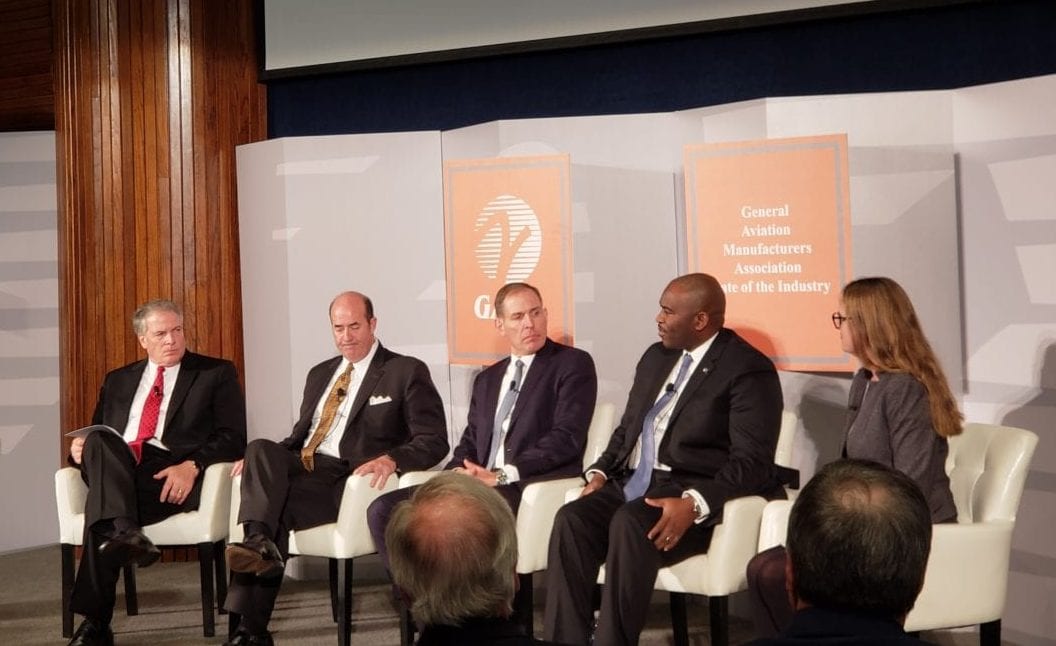
A panel at the GAMA state of the industry event. Left to right: GAMA’s Pete Bunce, Gulfstream’s Mark Burns, Jet Aviation’s David Paddock, Boeing Global Service’s William Ampofo and Terrafugia’s Anna Dietrich. (AVI)
Electric or hybrid-electric vertical-takeoff-and-landing (EVTOL) aircraft are a reality today, and that industry is working with the FAA to chart the course that will define the future of aviation.
That was one of the big takeaways at the General Aviation Manufacturers Association’s (GAMA) 2019 state of the industry event. GAMA’s membership includes 79 companies focused on EVTOL aviation.
“I think there is consensus among all of us that this is as important in aviation as the dawn of the jet age,” said GAMA President and CEO Pete Bunce.
Companies seem to take it seriously: Uber has said it expects to scale to more than 1,000 takeoffs per hour at each of the skyports it wants to install across the United States. Airbus and Audi are partnering on an air-and-ground on-demand mobility solution. American Airlines just teamed up with Blade.
The FAA with NASA in America, EASA and Eurocontrol in Europe and other regulatory bodies around the world are trying to figure out how they’re going to certify, accommodate and monitor all of this new technology occupying new space in the air. There is an urgency to that question as the technology is advancing quickly.
“A lot of people thought this wouldn’t happen until well into the 2020s. This is happening now,” Bunce said.
Because of that, on-demand mobility can help attract engineers to aviation, according to Anna Dietrich, co-founder of flying car company Terrafugia. It also means the new aviation trends, heavily featuring automation and angling toward unmanned vehicles, should be taken into account when training new pilots, she said.
“I think that we would be foolish to not take that into account,” Dietrich said, adding: “The person has always been the fallback, which isn’t using [automation] the best. The pilot doesn’t [need to] get tossed the hot potato of, ‘Oh, now there’s a problem, you deal with it.’ That has implications for pilot training, if the system retaining some responsibility even in the event of something going wrong.”
Bunce said that as automation in aircraft increases, he expects the licensing to change: a basic license will cover the privilege to fly certain aircraft, but pilots will need specific endorsements to fly ones with less automation.
“I don’t think it’s beyond reason that, in the future, to fly on steam gauges you’ll need an endorsement,” he said.
GAMA, which has a dedicated EVTOL subcommittee, is working with the FAA to smooth certification of those aircraft. Dietrich, who co-chairs that subcommittee, said that work with regulators is necessary for both the short- and long-term success of the EVTOL market.
“I think there is a very solid consensus that the Part 23 that was rewritten recently is a very solid basis on from which to build on a certification plan for this aircraft. But that’s just one piece,” she said. “We need to be playing the long game and working toward solutions that are durable, expandable, but we also need to be getting responsiveness and clarity in direction today on this crawl-walk-run approach that will get us to market.”
That is an issue that needs to be tackled from both the side of aircraft certification and airspace integration, which will require a lot of bodies working together to facilitate.
Bunce said talks with the FAA’s Teri Bristol, COO of its Air Traffic Organization, and Paul Rinaldi of the ATC union NATCA, have engendered confidence.
“We can do this,” he said. “They are not worried about that type of operation. If we are going to use these vehicles to be able to go and transit, say, from a suburban pickup point to the airport itself and we can go inside the security envelope so now we’re starting to relieve pressure on the TSA lines … we know that there is a model that will work and it can work in an urban area mixed with existing traffic that is in our hub airports.”
“I think where we’re headed is to do a crawl-then-walk approach to that as well, where we start with airspace corridors like the GA corridors that are in use today, where within those corridors the on-demand aircraft that are traveling there can fly and air traffic control will keep other traffic out,” Dietrich said.
“That is a baby step, it is a point-to-point solution, not a general sort of everywhere-you-want-to-go solution, but also, keep in mind that as much as we are charging full steam ahead, this is going to be a gradual implementation. We’re not going to start with 10 thousand aircraft tomorrow, so we will work up to larger volume.”
Things will have to scale quickly for Uber’s proposed thousands-per-hour model to be workable, but the infrastructure has to start somewhere while the airspace system, controllers, fellow aviators and the general public get used to the new kind of traffic.
“I think back to when we first started having automobiles on the street,” Dietrich said. “We didn’t have stop signs, we didn’t have streetlights, we didn’t have yellow lines down the center of the road, so as these vehicles become more and more mainstream, more and more prevalent, if we continue the collaborate, we have with all the parts of the FAA and air traffic control, I think we will come up with solutions that are safe and efficient and beneficial for everybody. But, it’s definitely a process.